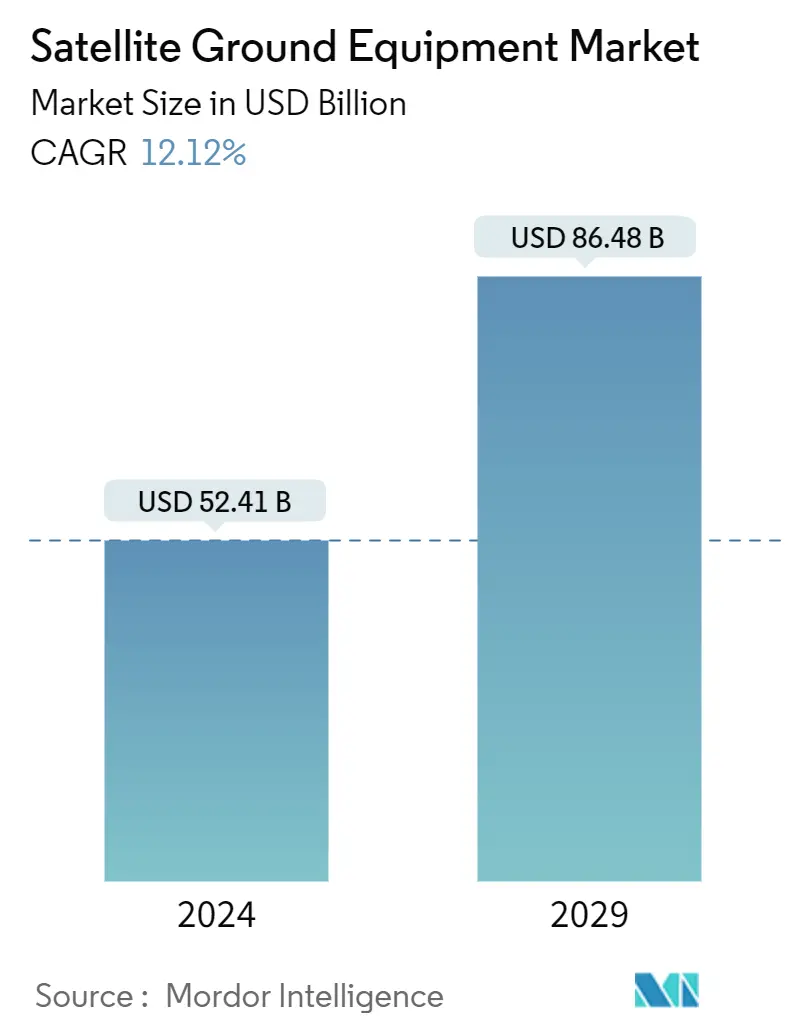Market Size of Satellite Ground Equipment Industry

| Study Period | 2019-2029 |
| Market Size (2024) | USD 52.41 Billion |
| Market Size (2029) | USD 86.48 Billion |
| CAGR (2024 - 2029) | 12.12 % |
| Fastest Growing Market | Asia-Pacific |
| Largest Market | North America |
Major Players_Market_Major_Players_Logo.webp)
*Disclaimer: Major Players sorted in no particular order |
Need a report that reflects how COVID-19 has impacted this market and its growth?
Satellite Ground Equipment Market Analysis
The Satellite Ground Equipment Market size is estimated at USD 52.41 billion in 2024, and is expected to reach USD 86.48 billion by 2029, growing at a CAGR of 12.12% during the forecast period (2024-2029).
- The satellite ground equipment industry has grown dramatically due to advancements in radio communication solutions, such as NOC equipment, the increasing demand for mobile radio communications, and the significant deployment of public safety applications. Furthermore, the profitable introduction of low earth orbit (LEO) satellite systems, high throughput satellites (HTS), and Ku- and Ka-band satellites are adding to the lucrative growth opportunities in the market. Simultaneously, the humongous demand for autonomous and connected vehicles used for various applications in the sectors, including commercial government and defense, require sophisticated customized SATCOM-on-the-move antennas for highly trusted operation, driving the Satellite Ground Equipment Market.
- The Satellite Industry Association (SIA) reported that the ground equipment revenues have significantly increased, with the extension in the GNSS markets and network equipment, flat or somewhat declining customer equipment investments and resources, manifesting that mobile satellite services will become a fundamental growth point of the overall market studied. Passengers using a smartphone or laptop in the air can benefit from in-flight connectivity to access the internet or video streaming services. Ship personnel may benefit from crew connectivity with the latest maritime information, such as chart updates, engine monitoring, and weather routing broadcast. The backpack terminals must be quickly and reliably deployed to support connectivity in harsh and emergent conditions.
- A High Throughput Satellite (HTS) is a satellite that provides high throughput compared with a fixed satellite system for the same amount of allocated frequency on orbit. HTS reuses the frequency and multiple spot beams to improve throughput and reduce the cost per bit delivered. HTS is primarily deployed to provide broadband Internet access service to unserved regions. Most HTS satellites are designed mainly for the enterprise, telecom, or maritime sectors. Space and satellite system providers are launching HTS satellites for high-speed communication services. The increasing HTS launches increase the adoption of ground station equipment , thereby driving the market.
- Satellite broadcasting is the distribution of multimedia content or broadcast signals over or through a satellite network. The broadcast signals usually originate from a station such as a TV or radio station. Then they are sent via a satellite uplink (uploaded) to a geostationary artificial satellite for redistribution or retransmission to other predetermined geographic locations through an open or secure channel. Direct broadcasting or satellite television has become an effective form of distribution for television content. The broad and controllable coverage areas and much larger bandwidths enable more channels to be broadcast, making satellite television very attractive.
- Furthermore, there is a diversity of satellite dish heaters and satellite antenna de-icing systems on the market in the present scenario, providing enough opportunities for everything from 18” residential satellite television and satellite Internet dish antennas to larger commercial and enterprise VSAT uses. Collecting snow and/or ice on a satellite television or satellite Internet dish can cause signal loss. The satellite de-icing system is one way to stop snow and ice from accumulating on satellite dishes.
- On the contrary, the multi-band terminals used by the Navy, which come with Advanced-EHF satellites, are quite expensive. Furthermore, the cost of purchasing and installing the terminals can be anywhere from 20 to 30 times that of the rockets and spacecraft. The fact that satellite and terminal development initiatives are carried out separately has long been a source of waste and cost overruns. For example, the Air Force may oversee spacecraft while the Army may oversee radios. Rarely do earth-bound communication equipment and satellites reach the conclusion of their development cycles at the same time. The high cost of satellite ground equipment services is limiting the market's expansion.
